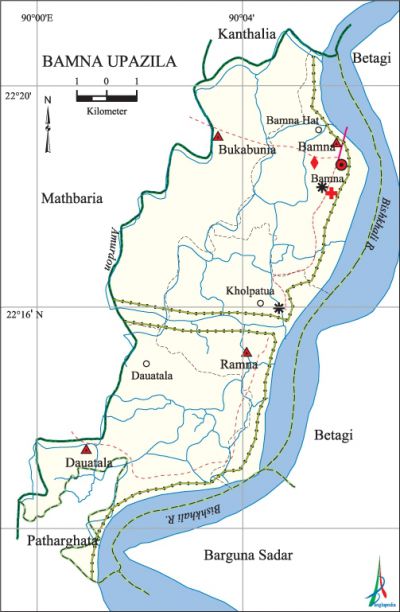Bamna Upazila
Bamna Upazila (barguna district) area 101.05 sq km, located in between 22°11' and 22°21' north latitudes and in between 90°00' and 90°07' east longitudes. It is bounded by kanthalia on the north, patharghata and barguna sadar upazilas on the south, Bishkhali river and betagi upazila on the east, mathbaria upazila on the west.
Population Total 69803; male 134721, female 35082; Muslim 64220, Hindu 5565 and others 18.
Water bodies Main rivers: bishkhali, Amurdon.
Administration Bamna Thana was formed in 1968 and it was turned into an upazila in 1983.
| Upazila | ||||||||
| Municipality | Union | Mouza | Village | Population | Density (per sq km) | Literacy rate (%) | ||
| Urban | Rural | Urban | Rural | |||||
|
- |
4 |
39 |
49 |
7106 |
62697 |
691 |
68.6 |
63.7 |
| Upazila Town | ||||||||
|
Area |
Mouza |
Population |
Density |
Literacy rate | ||||
|
5.41 |
2 |
7106 |
1313 |
68.57 | ||||
| Union | ||||
| Name of union and GO code | Area (acre) | Population | Literacy rate (%) | |
| Male | Female | |||
|
Dauatala 71 |
6292 |
8242 |
8361 |
65.29 |
|
Bamna 23 |
4944 |
9475 |
9208 |
63.65 |
|
Bukabunia 47 |
6030 |
8821 |
9151 |
65.54 |
|
Ramna 95 |
5584 |
8183 |
8362 |
62.35 |
Source Bangladesh Population Census 2001,Bangladesh Bureau of Statistics.

History of the War of Liberation During the war of liberation in 1971 the Pak army set on fire a number of houses of this upazila. The headquarters of the No. 9 sub-sector was at Bukabunia of the upazila. Bamna upazila was liberated on 23 November 1971.
Marks of War of Liberation Foundation pillar of sector 9 of the War of Liberation.
Religious institutions Mosque 240, temple 31, tomb 1, most noted of which is the tomb of Hazrat Khwaja Mohiuddin Hasan Chisti.
Literacy rate and educational institutions Average literacy 64.2%; male 66.6%, female 61.9%. Educational institutions: college 3, secondary school 11, primary school 48, madrasa 18. Noted educational institutions: Bamna Degree College (1982), Begum Faizunnesa Mahila Degree College (1996), Wazed Ali Khan College, Halta Dauatala Secondary School (1943), Sarwarjan Pilot Secondary School (1944), Asmanunnesa Girl's Secondary School (1966), Bukabunia Ideal Secondary School, Bamna Sadar R Rashid Fazil Madrasa (1987).
Cultural organisations Library 1, club 14, cinema hall 1.
Main sources of income Agriculture 65.19%, non-agricultural labourer 4.13%, industry 0.74%, commerce 12.08%, transport and communication 1.82%, service 8.04%, construction 1.29%, religious service 0.27%, rent and remittance 0.1% and others 6.15%.
Ownership of agricultural land Landowner 72.59%, landless 27.31%; agricultural landowner:' urban 66.43% and rural 73.59%.
Main crops Paddy, potato, wheat, corn, peanut, khesari, mug, gram, betel leaf.
Extinct or nearly extinct crops Sugarcane, tobacco, jute, sesame, linseed.
Main fruits Banana, jackfruit, betel nut, coconut, papaya.
Fisheries, dairies and poultries Fishery 15, poultry 40.
Communication facilities Pucca road 30 km, semi-pucca road 15 km, mud road 240 km; waterway 24 nautical miles.
Extinct or nearly extinct traditional transport Palanquin.
Noted manufactories Brick field, welding.
Cottage industries Goldsmith, blacksmith, weaving, potteries, wood work, embroidery, bamboo and cane work.
Hats, bazars and fairs Hats and bazars are 12, most noted of which are Bamna, Dauatala, Sahebbari bazars; Kholpatua and Bukabunia hats.
Main exports Betel leaf, khesari, banana.
Access to electricity All the unions of the upazila are under rural electrification net-work. However 6.58% (urban 73.23% and rural 66.43%) of the dwelling households have access to electricity.
Sources of drinking water Tube-well 92.14%, tap 0.16%, pond 6.2% and others 1.5%.
Sanitation 60.68% (rural 57.09% and urban 95.25%) of dwelling households of the upazila use sanitary latrines and 32.87% (rural 36.01% and urban 2.69%) of dwelling households use non-sanitary latrines; 6.45% of households do not have latrine facilities.
Health centres Upazila health centre 1, union health and family welfare centre 4, satellite clinic 4.
NGO activities Operationally important NGOs are brac, asa, Sangram. [MA Matin Akanda]
References Bangladesh Population Census 2001, Bangladesh Bureau of Statistics; Cultural survey report of Bamna Upazila 2007.
